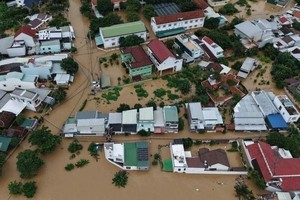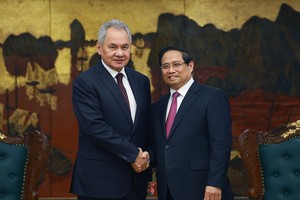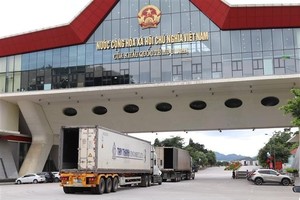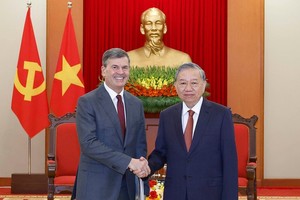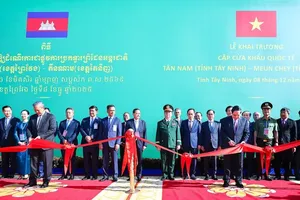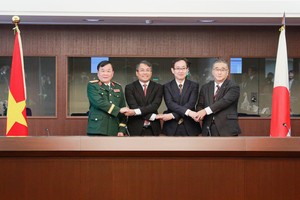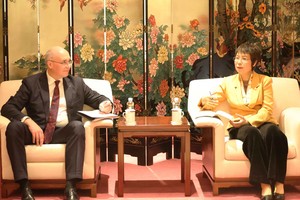Doubts over whether Japan can contain its nuclear crisis grew Thursday, as helicopters dumped water onto an overheating power plant and more foreign governments urged citizens to leave Tokyo.
Four military Chinooks ran a mission to empty containers holding more than seven tonnes of water each onto the nuclear facility damaged by Friday's massive earthquake and tsunami.
The operation aims to keep the fuel rods inside reactors and containment pools submerged under water, to stop them from degrading when they are exposed to air and emitting dangerous radioactive material.
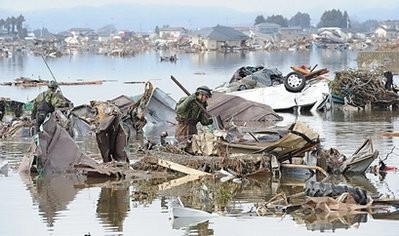
At the same time, Japanese engineers were focused on restoring the power supply to the stricken power plant in an attempt to reactivate its cooling system and avert a meltdown.
The power supply to the Fukushima No. 1 plant on the Pacific coast, some 250 kilometres (155 miles) northeast of Tokyo, could partially resume later Thursday, the country's nuclear safety agency said.
"If the restoration work is completed, we will be able to activate various electric pumps and pour water into reactors and pools for spent nuclear fuel," a spokesman for Plant operator Tokyo Electric Power Co. told AFP.
US President Barack Obama offered to give Japan any support that it needs, in a telephone call with Prime Minister Naoto Kan, the Japanese leader's spokesman said.
But as crews battled to prevent a disastrous meltdown, more foreign governments urged their citizens to steer clear of quake-stricken northeast Japan and the capital Tokyo.
Australia told its nationals to leave Tokyo amid the worsening crisis at the power plant and the threat of aftershocks.
"If you're in Tokyo or any of the affected prefectures... we are saying that you should depart," said Foreign Minister Kevin Rudd.
Britain advised its citizens to consider leaving Tokyo and northeastern Japan, though British officials said there is still "no real human health issue that people should be concerned about".
France's authorities said they were assigning two government planes to assist French citizens who wanted to leave Japan.
"Given the possible evolution of the situation, French citizens in Tokyo are recommended to leave the region for the south of the country or for France," the foreign ministry said.
US officials warned nationals living within 80 kilometres (50 miles) of the crippled Fukushima nuclear plant to evacuate or seek shelter.
The Japanese government has told people living up to 10 kilometres (six miles) beyond the 20-kilometre exclusion zone around the plant to stay indoors. More than 200,000 people have already been evacuated from the zone.
Germany, Italy and The Netherlands also advised their nationals to leave or refrain from travelling to the northeast.
"The site is effectively out of control," the European Union's energy chief Guenther Oettinger told a European Parliament committee, a day after he said Japan was facing "apocalypse."
France's Nuclear Safety Authority said the disaster now equated to a six on the seven-point international scale for nuclear accidents, ranking the crisis second only in gravity to the level-seven Chernobyl disaster in 1986.
US Energy Secretary Steven Chu said the events in Japan "actually appear to be more serious" than the 1979 accident at Three Mile Island, a partial reactor meltdown that led to small releases of radioactivity.
"To what extent we don't really know now," Chu said in Washington.
Gregory Jaczko, chair of the US Nuclear Regulatory Commission, warned there was no water left in the spent fuel pool of the plant's number-four reactor, resulting in "extremely high" radiation levels.
The US military will send a spy drone to take a closer look at the reactors in the troubled plant, Kyodo News reported.
UN atomic watchdog chief Yukiya Amano said the situation was "very serious" as he prepared to fly out to see the damage for himself.
Amano, the Japanese chief of the International Atomic Energy Agency, insisted Tuesday there was no comparison to the Chernobyl crisis, when radiation spewed across Europe.
Japan's chief government spokesman Yukio Edano said radiation levels from the plant posed no immediate health threat outside the 20-kilometre exclusion zone despite slightly elevated levels detected in Tokyo over the past few days.
Aside from the nuclear threat, the full scale of the quake and tsunami disaster was becoming clear as more details emerged of the staggering death and devastation in the worst-hit northeast.
"The number of people killed is increasing day by day and we do not know how many people have fallen victim," Japan's Emperor Akihito said in a rare televised address to the nation Wednesday.
"People are being forced to evacuate in such severe conditions of bitter cold, with shortages of water and fuel... I cannot help praying that rescue work is done swiftly and people's lives get better, even a little."
The official toll of the dead and missing after the quake and tsunami flattened Japan's northeast coast has exceeded 13,000, police said, with the number of confirmed dead at 5,178.
Millions have been left without water, electricity, fuel or enough food and hundreds of thousands more are homeless, stoically coping with heavy snowfalls, freezing cold and wet conditions in the northeast.
The governor of Fukushima prefecture, home to the crippled nuclear plant, said people were at breaking point.
"The worry and anger of the people of Fukushima has been pushed to the limit," Yuhei Sato told NHK.
But reports continued to come in which indicated that the final toll could be much higher, with the mayor of the coastal town of Ishinomaki saying the number of missing there was likely to hit 10,000, Kyodo News reported.
On Saturday, public broadcaster NHK reported that around 10,000 people were also unaccounted for in the port town of Minamisanriku, again in Miyagi prefecture.
